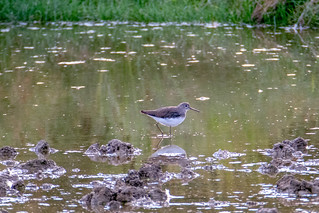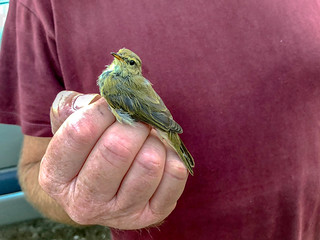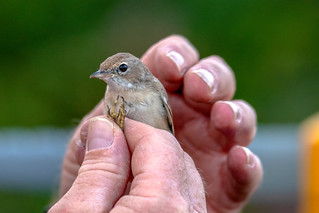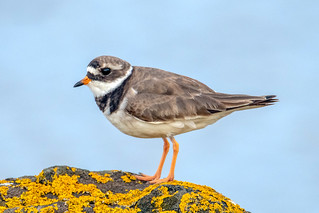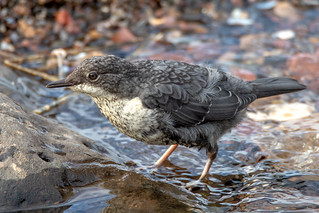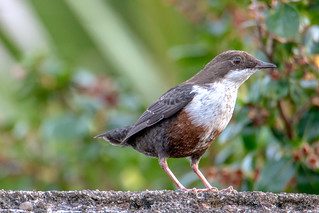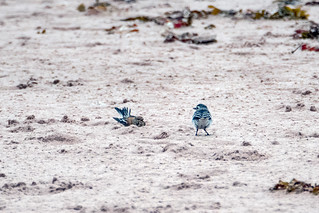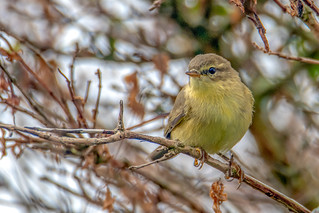No sooner than we arrived in the car park and put on our boots, than the heavens opened - we had to run for the cover of the Visitor Centre. No point in heading out yet as we would get soaked and hadn't bothered with waterproofs; after all it was meant to be dry (Sunday forecast to be wet). Started with lunch and watched the tits and finches on the range of feeders outside the window.
After lunch the sun came out and we decided that the shower had past. Taking our usual route round New Hare Covert we hoped to see the spotted flycatchers reported the previous day. Strangely I caught up with Charlotte and she was waiting under a tree - apparently she thought it would make good cover from the rain - although it wasn't raining ... yet. I suggested we push on to the tall trees as it would likely give us better cover (mistake).  Within 25m the rain started and we hurried to some trees ahead and took refuge - the rain only got heavier and over around 5 minutes we started to get quite wet. With no let up in sight I decided to make a run for it to the larger wood - even though this would mean running through heavier rain, I was already wet. Once there we were better protected but not completely out of the falling rain. Standing still we were able to pick out a treecreeper on the opposite side of the path to our usual.
Within 25m the rain started and we hurried to some trees ahead and took refuge - the rain only got heavier and over around 5 minutes we started to get quite wet. With no let up in sight I decided to make a run for it to the larger wood - even though this would mean running through heavier rain, I was already wet. Once there we were better protected but not completely out of the falling rain. Standing still we were able to pick out a treecreeper on the opposite side of the path to our usual.
The rain started to ease and we pushed on. Just beyond the turn to the Wright Hide we came across a small flock of willow warbler to our right (Swallow Pool) - 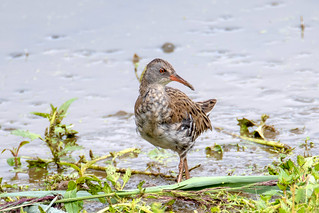 at least 7. From the hide we had geese, lapwing, coot, moorhen (and young of the latter two). There were also numbers of teal and gadwall in eclipse.
at least 7. From the hide we had geese, lapwing, coot, moorhen (and young of the latter two). There were also numbers of teal and gadwall in eclipse.
On to the East Marsh hide. As we entered there was a couple already in residence - they excitedly told us that they had been watching a pair of water rail in front of the hide for the last 20 minutes. On Thursday they had been trimming and cutting banks and islands on the East Marsh pool and this must have exposed the area ahead of us - although disrupted this seems to have drawn a crowd! - two showed briefly but one chased the other back out of sight.
We waited only for a couple of minutes 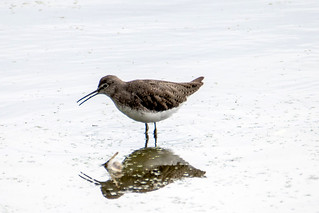 and out popped a water rail, which I assume is a juvenile due to colouring and feathering. We were entertained but with increasingly heavy skies overhead. The rain started again and as it did a green sandpiper dropped in to the waters edge. It only stayed a moment as it was quickly chased away by feeding moorhen chicks. The chap showed us a photo to see if we could identify it and it was a greenshank - it had been in front of the hide for just a minute and been chased away by the coot and moorhens - I wasn't to see one this time. The rain chucked it down and we decided to stay put.
and out popped a water rail, which I assume is a juvenile due to colouring and feathering. We were entertained but with increasingly heavy skies overhead. The rain started again and as it did a green sandpiper dropped in to the waters edge. It only stayed a moment as it was quickly chased away by feeding moorhen chicks. The chap showed us a photo to see if we could identify it and it was a greenshank - it had been in front of the hide for just a minute and been chased away by the coot and moorhens - I wasn't to see one this time. The rain chucked it down and we decided to stay put.
Carlton and Ted Jury Hides were very quiet and yielded nothing of any consequence, 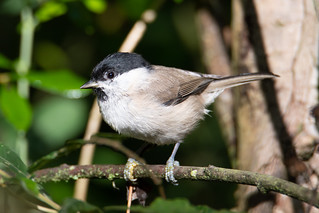 although we did see a small group of whitethroat between the two.
although we did see a small group of whitethroat between the two.
We dropped into the Baldwin Hide on our way back but didn't add to our sightings on the water, seeing only a small flock of long-tailed tits working along the trees at the waters edge.
When I left the hide I saw some birds chasing one another on the tops of the trees but couldn't pick out what they were. I stopped and waited but Charlotte soon got bored of this and headed up to the tea-room to pick up a hot chocolate and coffee before it shut at 3.45pm. I soon managed to view the birds and found they were garden warbler. Satisfied I went back to the reserve Visitor Centre but as I passed the Carlton ditch I saw a bird flash to my right, sporting a black cap. Waiting, it turned out to be a pair of willow tit. Absolutely gorgeous.
Sightings (36) included: black-headed gull, blue tit, buzzard, canada goose, carrion crow, chaffinch, common tern, coot, cormorant, dunnock, gadwall, garden warbler, great tit, green sandpiper, greenfinch, grey heron, greylag goose, house martin, lapwing, long-tailed tit, mallard, moorhen, pheasant, reed bunting, robin, rock dove / feral pigeon, sand martin, swallow, teal, treecreeper, tufted duck, water rail, whitethroat, willow tit, willow warbler and woodpigeon.

